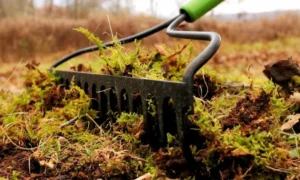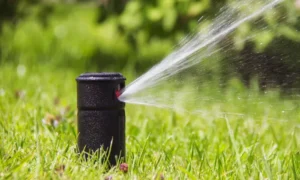
Low Maintenance Front Yard Landscaping Tips and Ideas
Low Maintenance front yard landscaping plays a crucial role in enhancing the overall aesthetic appeal of a property while also serving functional purposes. It’s often
In the hustle and bustle of modern life, the backyard serves as a sanctuary for relaxation and entertainment. However, the traditional grassy lawn may not always be the most practical or stylish choice. If you’re looking to revamp your outdoor space with a modern touch and without the hassle of maintaining a grassy lawn, Robert Complete Care has you covered. In this article, we’ll explore innovative and chic ideas to transform your backyard into a contemporary oasis.

Traditional grass may require regular maintenance, but a well-designed hardscape can significantly reduce the need for upkeep while adding a touch of sophistication to your backyard ideas. Consider using materials like pavers, stones, or concrete to create pathways, patios, or even an outdoor living room. Robert Complete Care specializes in creating durable and stylish hardscapes that not only enhance the aesthetic appeal but also minimize maintenance efforts.
Embrace the beauty of nature without the need for a traditional lawn by incorporating xeriscaping into your backyard design. This water-efficient landscaping approach utilizes drought-resistant plants, gravel, and mulch to create a visually appealing and low-maintenance environment. Robert Complete Care can assist you in selecting the perfect combination of plants and materials to achieve a vibrant, eco-friendly landscape that stands the test of time.
For those who desire the look of a lush green lawn without the hassle of mowing and watering, artificial turf is an excellent solution. Robert Complete Care offers high-quality artificial grass installations that mimic the appearance of natural grass while requiring minimal maintenance. Enjoy a vibrant green space year-round without the need for pesticides or excessive watering.
Create a seamless transition between indoor and outdoor living with carefully designed outdoor spaces. Install a chic deck, pergola, or patio where you can entertain guests or unwind after a long day. Robert Complete Care specializes in crafting functional and stylish outdoor living areas that cater to your specific needs, whether it’s a cozy reading nook or a spacious entertainment zone.
Maximize your greenery without sacrificing valuable floor space by incorporating vertical gardens into your backyard design. These living walls not only add a contemporary and artistic flair to your outdoor space but also provide a breath of fresh air. Robert Complete Care can help you design and install vertical gardens that complement your aesthetic preferences and thrive in your local climate.
Elevate the ambiance of your backyard with carefully placed lighting elements. Consider string lights, lanterns, or strategically positioned spotlights to create a warm and inviting atmosphere. Robert Complete Care can guide you in choosing the right lighting fixtures that not only enhance the visual appeal of your outdoor space but also contribute to safety and functionality.
Extend the usability of your backyard into the cooler months by incorporating fire features. Whether it’s a stylish fire pit or a modern outdoor fireplace, Robert Complete Care can help you design a focal point that adds warmth and charm to your outdoor gatherings. Enjoy cozy evenings under the stars without the need for a traditional grassy lawn.
Robert Complete Care as your partner in transforming your backyard, you can say goodbye to the limitations of a traditional grass lawn. Embrace modern and sustainable alternatives that not only enhance the visual appeal of your outdoor space but also minimize maintenance efforts. Whether you opt for elegant hardscaping, vibrant xeriscaping, or artificial turf, the possibilities are endless. Feel free to contact us with any questions or concerns.
What Are Modern Backyard Ideas With No Grass?
Modern backyard ideas with no grass focus on creating stylish, low-maintenance outdoor spaces that eschew traditional grass lawns. These ideas include various landscaping elements, such as hardscaping, native plants, mulch, gravel, and outdoor structures, to achieve an appealing and contemporary look.
Why Should I Consider Modern Backyard Ideas With No Grass?
Modern backyard ideas with no grass offer several benefits. They require less water, maintenance, and upkeep compared to traditional grass lawns. Additionally, they allow for more creative design options, provide space for outdoor activities, and contribute to a sustainable and eco-friendly environment.
What Are Some Alternative Landscaping Options For A Grass-Free Backyard?
Several alternative landscaping options include:
How Do I Choose The Right Plants For A Grass-Free Backyard?
Select plants that are well-suited to your climate and soil conditions. Native plants are often a good choice as they require less water and maintenance. Consider factors like sun exposure, water requirements, and growth patterns when choosing plants to ensure they thrive in your backyard.

Low Maintenance front yard landscaping plays a crucial role in enhancing the overall aesthetic appeal of a property while also serving functional purposes. It’s often

How to get rid of moss in your lawn can be a persistent problem, often appearing as a dense, green carpet that outcompetes grass for

Lawn fungus represents a significant challenge for homeowners and landscape professionals, impacting the aesthetic and health of lawns. These fungal infections can manifest as unsightly

Best time to water lawn and maintaining a lush, green lawn often involves more than just regular mowing. One crucial aspect of lawn care is

Ensuring optimal grass growth is crucial for maintaining a lush and healthy lawn. One of the key factors in achieving this is using the right

In the bustling metropolis of the sprinkler repair los angeles, where the sun shines almost year-round and the risk of fires is a constant concern,

Robert’s Complete Care has a proven track record of providing creative, high-quality lawn care Whittier services, CA area.
Copyright © 2023. All rights reserved Robert's Complete Care | Powered by Localpro1.